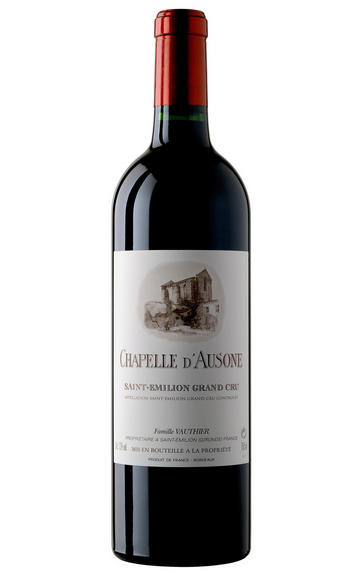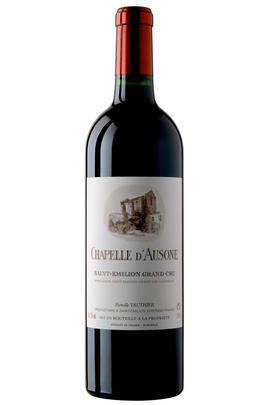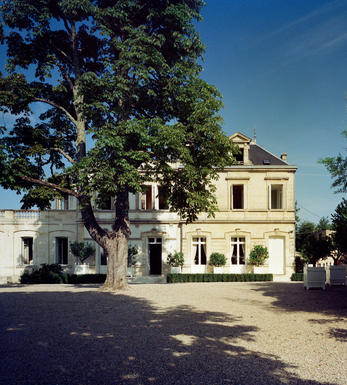
1996 Château Ausone, St Emilion, Bordeaux

Critics reviews
The 1996 Ausone is a vintage that I have tasted on four or five occasions. This was similar to previous examples with a very floral and outgoing bouquet, those wilted violet petals infusing the boysenberry and blueberry fruit, quite glossy in style, one of the most modern of that decade. It certainly has more intensity than earlier vintages.
The palate is medium-bodied with sweet and ripe tannin, impressive acidity and weight, although it does not revel in the complexity of other vintages, perhaps because the growing season did not favour the Right Bank. There is a touch of headiness on the finish that is a little otiose, but otherwise, this is a thoroughly enjoyable Ausone—tasted at the Ausone vertical in London.
Drink 2018 - 2038
Neal Martin, Vinous.com (March 2018)
Notably deep crimson. Very very intense, almost burnt nose. It is round and soft with lots packed in there – but a bit awkward at present. Iron fist in a velvet glove stuff but with oddly rustic tannins on the finish. I think this was an interim vintage before Alain Vauthier really got into his stride.
Drink 2010 - 2025
Jancis Robinson MW, JancisRobinson.com (April 2006)
A brilliant Ausone, the 1996 displays this property's tell-tale mineral characteristic in its multidimensional bouquet. In addition, there is a plum-like liqueur intermixed with black currants, cold steel, floral, and crushed stone scents. Dense, rich, and extremely subtle, this medium-bodied Ausone possesses extraordinary richness yet no sense of heaviness. It takes the prize for having a rare equilibrium of flavour and structure.
As the wine sat in the glass, I was convinced I smelled violets or something that reminded me of the 1990 Comte de Vogue Musigny. Undoubtedly one of the great wines of the vintage, the 1996 Ausone will require a decade of cellaring.
Anticipated maturity: 2006 - 2050
Robert M. Parker, Jr., Wine Advocate (February 1998)
Full red-ruby. Exotic aromas of black cherry, cassis, minerals, smoke, clove and mint. Thick with extract, but with Ausone classic restrained sweetness and mineral backbone. Sound acidity gives the flavours superb clarity and grip. It finishes with extremely persistent, subtle fruit and noble, palate-saturing tannins. It's extraordinarily fine for a right-bank wine from this vintage.
Alain Vauthier's potentially great '98 is one of the most complex wines of the vintage from one of Bordeaux's greatest sites. Ausone harvested between September 28 and October 5 in "a series of small bursts," according to Vauthier, and even the cabernet franc here came in with potential alcohol in the high 12.8% range. The extraction is relatively short here, and in '98, Vauthier carried out less frequent, gentler remontages. "The more I taste, the more I think people here are overworking their wines," said Vauthier.
Stephen Tanzer, Vinous.com (May 1999)
About this WINE

Château Ausone
Château Ausone is a wine estate in St Emilion on the Right Bank of Bordeaux. It takes its name from the poet Ausonius, who is thought to have owned a villa where the estate stands today – just outside the medieval village of St Emilion. Ausone’s vineyards sit atop St Emilion’s limestone plateau and extend in terraces down the côtes. There are just over six hectares of vines planted today, mostly Cabernet Franc along with Merlot. The team practice organic and biodynamic viticulture though without certification.
The estate belongs to the Vauthier family, led by Alain Vauthier and his children, Pauline and Edouard. In 1955, Ausone was ranked at the very top of the St Emilion classification – as Premier Grand Cru Classé A – alongside Château Cheval Blanc. In 2021, both Ausone and Cheval Blanc announced that they were voluntarily withdrawing from the classification.
Ausone is known for its structured, long-lived wines. A second wine, Chapelle d’Ausone, was introduced in the 1990s. The Vauthier family also own a number of other properties nearby in St Emilion, including Château Moulin Saint-Georges, Château La Clotte and Château de Fonbel.

St Émilion
St Émilion is one of Bordeaux's largest producing appellations, producing more wine than Listrac, Moulis, St Estèphe, Pauillac, St Julien and Margaux put together. St Emilion has been producing wine for longer than the Médoc but its lack of accessibility to Bordeaux's port and market-restricted exports to mainland Europe meant the region initially did not enjoy the commercial success that funded the great châteaux of the Left Bank.
St Émilion itself is the prettiest of Bordeaux's wine towns, perched on top of the steep limestone slopes upon which many of the region's finest vineyards are situated. However, more than half of the appellation's vineyards lie on the plain between the town and the Dordogne River on sandy, alluvial soils with a sprinkling of gravel.
Further diversity is added by a small, complex gravel bed to the north-east of the region on the border with Pomerol. Atypically for St Émilion, this allows Cabernet Franc and, to a lesser extent, Cabernet Sauvignon to prosper and defines the personality of the great wines such as Ch. Cheval Blanc.
In the early 1990s there was an explosion of experimentation and evolution, leading to the rise of the garagistes, producers of deeply-concentrated wines made in very small quantities and offered at high prices. The appellation is also surrounded by four satellite appellations, Montagne, Lussac, Puisseguin and St. Georges, which enjoy a family similarity but not the complexity of the best wines.
St Émilion was first officially classified in 1954, and is the most meritocratic classification system in Bordeaux, as it is regularly amended. The most recent revision of the classification was in 2012

Cabernet Sauvignon Blend
Cabernet Sauvignon lends itself particularly well in blends with Merlot. This is actually the archetypal Bordeaux blend, though in different proportions in the sub-regions and sometimes topped up with Cabernet Franc, Malbec, and Petit Verdot.
In the Médoc and Graves the percentage of Cabernet Sauvignon in the blend can range from 95% (Mouton-Rothschild) to as low as 40%. It is particularly suited to the dry, warm, free- draining, gravel-rich soils and is responsible for the redolent cassis characteristics as well as the depth of colour, tannic structure and pronounced acidity of Médoc wines. However 100% Cabernet Sauvignon wines can be slightly hollow-tasting in the middle palate and Merlot with its generous, fleshy fruit flavours acts as a perfect foil by filling in this cavity.
In St-Emilion and Pomerol, the blends are Merlot dominated as Cabernet Sauvignon can struggle to ripen there - when it is included, it adds structure and body to the wine. Sassicaia is the most famous Bordeaux blend in Italy and has spawned many imitations, whereby the blend is now firmly established in the New World and particularly in California and Australia.


Buying options
Add to wishlist
Description
The 1996 Ausone is a vintage that I have tasted on four or five occasions. This was similar to previous examples with a very floral and outgoing bouquet, those wilted violet petals infusing the boysenberry and blueberry fruit, quite glossy in style, one of the most modern of that decade. It certainly has more intensity than earlier vintages.
The palate is medium-bodied with sweet and ripe tannin, impressive acidity and weight, although it does not revel in the complexity of other vintages, perhaps because the growing season did not favour the Right Bank. There is a touch of headiness on the finish that is a little otiose, but otherwise, this is a thoroughly enjoyable Ausone—tasted at the Ausone vertical in London.
Drink 2018 - 2038
Neal Martin, Vinous.com (March 2018)
wine at a glance
Delivery and quality guarantee